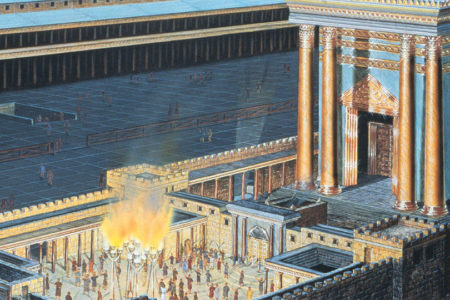The Dedication of a King
In every parent’s life there are those timeless moments when a newborn child nestles gently into his or her arms. With large, innocent eyes, the trusting infant looks up at its reassuring protector. A tiny hand grips a solitary grown-up finger. What father, when stroking that smooth, delicate skin, does not catch his breath in awe and wonder at the creative power of God? What mother, when filled with gratitude for such a gift, does not wonder what the little one will be when it grows up? Will the child become a doctor? A teacher? A farmer? A president?
Most of us have not had the privilege of glancing into our children’s futures. In Bible days, however, some parents did have that opportunity. Two such parents were Mary, the mother of Jesus, and her husband Joseph. Their story is found in Luke 2:22–39.
Purification of the Mother
According to Leviticus 12, a woman who had given birth to a son was unclean for 40 days. During the first seven days, the new mother was quarantined to avoid making anyone else unclean by mere touch. After this, she could move about freely, but she could not go up to the Temple. Rabbinical law even forbade new mothers to be anywhere on the Temple Mount.
It was after this period of maternal purification that Mary and Joseph came up to Jerusalem. They were there to accomplish two things.
The first was to offer sacrifices on Mary’s behalf. On the 41st day of Jesus’ life, Mary and Joseph, with the baby Jesus, entered the Temple area, most likely on the north side through the Gate of the Women. Then they headed east toward the treasury, the area of colonnades that surrounded three sides of the Court of the Women. Throughout these colonnades were 13 Shofar or Trumpet Chests, so named because of their tapered shape. There Mary found the chest marked “bird offerings” and deposited the price for the required sacrifices—a lamb for a burnt offering and a pigeon or turtledove for a sin offering. If a family was poor and could not afford a lamb, as apparently was the case with Mary and Joseph, a second pigeon or turtledove could be substituted. A priest then sacrificed the birds, and Mary was pronounced ceremonially clean, after which she was permitted to roam the Court of the Women freely. Mary’s atonement was indicative of the fact that she, like everyone else, was not sinless. She had to make atonement to avoid defiling God’s place of abode, which would have caused her death (Lev. 15:31).
As Mary paid the price for purification and the priest sacrificed the birds, little did she realize that the baby boy in her arms would one day pay the ultimate price for the ultimate sacrifice so that she and all mankind could receive the ultimate purification.
Presentation of the Son
Second, Joseph and Mary brought Jesus up to Jerusalem to present Him to the Lord. This entailed the ceremony of pidyon ha-ben (redemption of the [firstborn] son). Based on Exodus 13:2, 14–15, every firstborn son belonged to the Lord. Later, God chose the Levites to take the place of the firstborn (Num. 8:14, 16–18). Thereafter, every firstborn belonged to the priests and Levites. But in order to release the firstborn from their obligation, God demanded that they be redeemed (Num. 18:15–16).
For the redemption ceremony, the father brought the child to a priest. The mother was not obligated to attend the ritual but often did so. The priest held the child while the father gave the priest five silver shekels in the place of his son. The priest then returned the child to the father. This ceremony is still practiced today by Orthodox Jews. In the United States, five silver dollars replace the shekels.
The redemption was usually carried out no earlier than the 31st day of the child’s life. If it was not possible or convenient to bring the child on the 31st day, the law permitted him to be brought at some later date. For the redemption to be valid, the Bible instructed only that the child be at least a month old. Since it was permissible to wait longer to fulfill the ceremony of pidyon ha-ben, Joseph apparently decided to postpone the event for Jesus until both he and Mary could go up to the Temple together.
After Mary had completed her purification sacrifices, she and Joseph brought the baby Jesus into the Court of the Women “to do for him after the custom of the law” (Lk. 2:27). They were looking for a priest to carry out the redemption of the firstborn.
Prophecy of the Servant
The man they found was Simeon. Although the biblical text does not specifically say that he was a priest, in all likelihood he was. It was Simeon who held the baby and uttered the benedictions—traditional priestly duties related to the pidyon ha-ben ceremony.
Simeon was a special man with a special purpose. A resident of Jerusalem, he was characterized by a number of godly virtues. He was just and devout, which means that he habitually observed and obeyed God’s directives. Simeon was also a man of deep spiritual longings who waited expectantly for heavenly relief. He did not ask for this relief for himself, but for his people, his nation. Simeon was in a constant state of anticipation for the “consolation of Israel” (Lk. 2:25). He was a man of faith, anxiously looking for the day when the Messiah would come and fulfill the promise of comfort given to his people in Isaiah 40:1 and 61:2.
Simeon also enjoyed the presence of the Holy Spirit upon his life. At some point in his past, the Holy Spirit had given him a direct revelation that contained a promise regarding his sight, both literally and figuratively. God had promised Simeon that he would see two things, and the second thing would not occur until he had seen the first. The first would be the Lord’s Christ or Messiah, and the second would be death. Doubtless each morning Simeon would rise and wonder, “Is this the day?” If Simeon actually was a priest, he certainly must have performed hundreds of pidyon ha-ben rituals. With each one, Simeon would lovingly embrace the little baby boy, peer into his eyes, and, like Samuel of old at the house of Jesse, wait for the Lord’s indication that this was His anointed.
When, in the Spirit, Simeon entered the Temple that day, he met Mary and Joseph. Taking the baby Jesus into his arms, he somehow knew that this was the one, and Simeon broke into praise. This humble servant addressed his Lord, respectfully asking Him for a peaceful release from his duties because he had finally seen God’s salvation with his own eyes. (Jesus literally means salvation in Hebrew.) To the Gentiles, this salvation would be a revealing light of truth, as predicted in Isaiah 9:2. To the nation of Israel, God’s salvation would be its glory (Lk. 2:32).
As Joseph and Mary marveled at what was being said about their little boy, Simeon went on to bless them. In addition, this man, who had been given a revelation concerning the purpose of his own life, now saw a prophetic vision concerning the purpose of Jesus’ life. Directing his comments to Mary, Simeon explained that before her son became Israel’s glory, He would become a marked man, constantly being opposed, and causing the fall and rise of many in Israel. This was His destiny—to bring to light the true schemes of mankind’s wicked heart. As for Mary, even she would not escape the impact of her little one’s life. Instead of exhilaration, Mary would experience such agony that it would be like having a sword driven through her soul.
Proclamation of the Widow
As Simeon was finishing his discourse, a nearby widow suddenly began crying out publicly, giving thanks to Almighty God. This was no ordinary woman. This was Anna, a prophetess, who never left the Temple—the place of God’s abode—where she spent her time in prayer and fasting.
She had seen much hardship during her 84-year life span. She lost her husband after only seven years of marriage. She saw the last of the Hasmonean kings bicker and fight for power, bringing Israel to ruin. As a young woman of about 25, she saw the Roman army march into Jerusalem under Pompey’s direction, slaughter 12,000 Jews, and make Israel a tribute-paying Roman province. For the last 33 years she had watched as a murderous Idumean usurper named Herod was proclaimed king of the Jews. How she longed for the day when the true Son of David would come and take His rightful place on the royal throne.
Now, having heard the blessing and prophecy of Simeon, Anna knew that the time of God’s visitation had finally arrived. From that day on, she became an irrepressible herald. She incessantly spread the news to all who were like-minded—those who, like Simeon and herself, were waiting for the redemption of Jerusalem through the coming of the Messiah.
Principles for the Redeemed
What marvelous lessons we can learn from such examples as Simeon and Anna. For those who do not know Jesus the Messiah, the principle that pervaded Simeon’s life is the place to start: look to Christ first, then you can die in peace.
Those of us whose lives have already been changed by faith in Jesus should, like Anna, tell everyone we can about the Redeemer. The Scripture says, “How beautiful upon the mountains are the feet of him that bringeth good tidings, that publisheth peace; that bringeth good tidings of good, that publisheth salvation; that saith unto Zion, Thy God reigneth!” (Isa. 52:7). Although an 84-year-old woman’s feet may not normally be very attractive, in God’s eyes Anna’s feet must have been absolutely stunning.
Finally, as with both Simeon and Anna, we as Christians should wait expectantly for the coming of the Messiah—this time for His bride, the church. As Paul stated in Titus 2:13, we should be “Looking for that blessed hope, and the glorious appearing of the great God and our Savior, Jesus Christ.” Like Simeon, our daily attitude should be, “Is this the day?”
The text in Luke concludes by stating that Joseph and Mary left Jerusalem after having fulfilled the requirements of the law (Lk. 2:39). It is asserted no less than five times in this passage that their activities were in response to biblical Judaism.
This is important to understand because some people today question the authentic Jewish origin, life, and ministry of Jesus of Nazareth. They may say, “If Jesus was the Messiah, where is the consolation of Israel? Where is the redemption of Jerusalem?”
We must remember that 33 years after the events recorded in Luke 2 occurred, there were others asking the same questions. There they were, watching Jesus of Nazareth dying horribly before their eyes. Some of them may have been the very ones who had heard Simeon and Anna’s testimonies years before. Like the disciples on the road to Emmaus, they were saying among themselves, “we hoped that it had been he who should have redeemed Israel” (Lk. 24:21). They did not understand that even though there will yet be a future redemption for Israel nationally, Jesus the Messiah first had to provide another type of redemption. In Him “we have redemption through his blood, the forgiveness of sins, according to the riches of his grace” (Eph. 1:7).
Where was the consolation? Where was the redemption? It was right there, hanging on a cross.









Awesome teaching. I am also one who studies the feast of the Lord and I marvel at the accuracy of the prophetic words predicted by these rehearsals and their timely fulfillment. I would like to hear more of your teachings on these subjects of the feast of Israel and the seasons of Messiah.